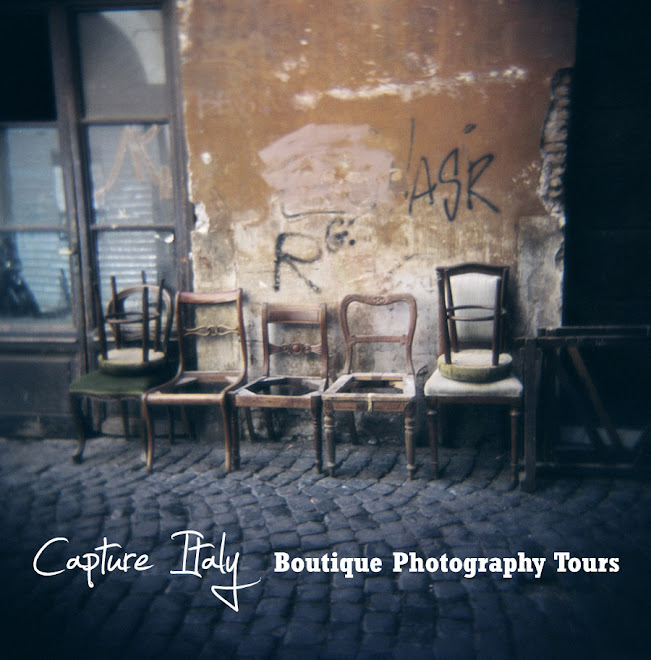The story behind the image:
Almost everyone who joins us on tour wants to learn techniques to photograph people. Capturing people is such an important part of travel photography, so let's look at some images taken in Italy on our tours and get the discussion started...
It's one of the questions we get asked most on tour - how do I photograph people?
The answer is very simple. It depends on what story you are telling.
There are three generally identified types of portraits (for the purpose of this blog we will use the term "portrait" to refer to any type of image that contains people).
Candid portraits (aka "fly on the wall") - the subject is not engaged directly with the camera; the subject may or may not be aware that you are photographing them. In instances where the subject is not aware of your presence, these type of portraits probably fit equally into the street photography / social documentary genres.
Environmental portraits - the subject is captured in his/her/their environment or background.
Formal portraits - the subject is engaged with the camera and is the only focus of the image, with little or no background.
Most of us have a preference for the type of people shots we take, however when you're travelling you will need to be able to capture all three types of portraiture as circumstances (and your story) dictate.
The image above is one of my personal favourites. It was taken on a reconnaissance visit to Sicily, in a bar (cafe) in Ragusa. I was inside the bar having a refreshing granita and taking a rest from the heat outside. Daily life was unfolding in front of me, and this was a moment I enjoyed capturing.
Given our definitions of portraits, it's quite easy to see that this is a candid portrait. I didn't hide my camera, however I did not engage with the people in the bar. Had I spoken with the gentleman reading his newspaper, or the grandfather and child at the bar, the image would not have told the story I wanted. It would have lost its "slice of life" content.
Each photographer must make their own decisions about candid portraits. I have heard a number of respected photographers viciously attack the candid portrait (where the subject is unaware of the photographer) as being akin to stealing a subject's soul. I have also read a number of superb essays on the value of candid images in documenting time and place in history - think Cartier-Bresson and his amazing images of Scanno.
My personal moral standing is this: if I keep my camera visible and I treat people with respect in my capture of them, then I feel perfectly comfortable with candid portraits irrespective of whether the subject is aware of my presence or not. Remember, this is my personal moral code. You will need to think through and identify your own.
This image below is an obvious environmental portrait. In this image, the skipper is shown in his natural environment. A head-and-shoulders portrait would not have told the same story. He also looks incredibly comfortable and relaxed. That is the beauty of environmental portraits - your subjects are likely to be in their comfort zone, so less self-conscious.
Most environmental portraits lend themselves to wide-angle lenses to ensure the background can be included as part of the story. This image was taken at a focal length of 35mm.
I feel that these are the most challenging types of portraits in travel photography. It is difficult for formal portraits to stand alone and tell a story without some sense of context - particularly in a country such as Italy where there is no clothing or even facial features that specifically identifies a subject as being a local Italian. BUT these portraits are often the most rewarding to take, and they will add to the depth of your story.
Often when you ask someone if you can take their photo, they will pose the way they expect you would want them to - a cheesy or forced smile. I will take that image, chat some more and then ask them to pose in a specific manner. In the images below, the gentleman posed with his cigarette, then he smoked it while we chatted, and then I asked him if I could take another shot. I asked him just to look directly into the camera. The second shot is the one I was after.
I enjoyed chatting with this man, he was a real character.
A few tips for people photography:
- before you even turn the camera on, be aware of any cultural or religious reasons that may prohibit or restrict photography
- know how to use your camera and what shot you want before approaching someone to take their photo - it enables you to work quickly, ensuring the subject doesn't become too self-conscious
- don't be afraid to approach people - for every no there will be a yes... but...
- be polite and respectful, and treat your subjects the way you would like to be treated and photographed
- if you intend to sell (or enter into public competitions) the images you are taking, consider getting your subject to sign a model release form of some sort - in this risk-minimising, litigious world anything could happen
Equipment and settings used in top image:
Camera - Canon EOS 5D
Settings - f4, 1/80s, ISO 1600, auto white balance, neutral picture style, shot in RAW
Lens - Canon EF 24-70mm f2.8L USM LENS
Focal length: 57mm
Happy Shooting from Lisa and Dianne at Capture Italy










